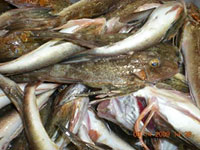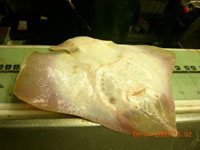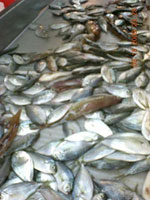

 | |||||||||||||||||
|
|
Journals 2009/2010Beth Brocato
September 16, 2009 I forgot to show you the picture of the Sand Bar shark we caught yesterday.
This morning the waters were so calm that in the dark it was hard to tell we were actually moving in water. Today we are almost at the southernmost region of the survey. It shows since we are sorting species much different from those found in and around the New England waters.
 Today's stations were also to be some of the deepest trawls we would do on this trip. Even though my shift started at midnight, it was 3 o'clock before our first sort. Unfortunately, the computer that tracks the net's progress calls this a "bad tow." This is probably because there may have been a time when the net was not touching bottom. We sorted this batch, but it will not count for scientific data. Finally, about 10:30 a.m. we waited for the net to come up for our final sort of the shift. We watch the indoor camera and everyone's mouth dropped. This was the biggest catch yet! When the net dropped the catch in the sorter, the watch chief noted that the majority of the catch was butterfish. So, our job was to let the butterfish go to the end of the conveyor and pull out everything else. It took us 90 minutes just to sort this catch. This single catch weighed over two tons (4000 lbs.)!
Luckily the day shift came on at noon, so it was left to them to catalogue the catch. |
||||||||||||||||



